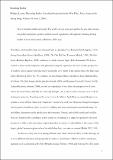Files in this item
Breathing bodies : sounding subjectivity in the war film
Item metadata
| dc.contributor.author | Lovatt, Philippa | |
| dc.date.accessioned | 2018-12-01T00:50:38Z | |
| dc.date.available | 2018-12-01T00:50:38Z | |
| dc.date.issued | 2016-12-01 | |
| dc.identifier | 252058674 | |
| dc.identifier | c65e1449-a54c-4c99-9800-17703745304a | |
| dc.identifier.citation | Lovatt , P 2016 , ' Breathing bodies : sounding subjectivity in the war film ' , Music, Sound, and the Moving Image , vol. 10 , no. 2 , pp. 167-188 . https://doi.org/10.3828/msmi.2016.9 | en |
| dc.identifier.issn | 1753-0768 | |
| dc.identifier.other | ORCID: /0000-0001-9369-8169/work/65014601 | |
| dc.identifier.uri | https://hdl.handle.net/10023/16604 | |
| dc.description.abstract | In this article, through close comparative analysis of the sound design of two Iranian films, Bahram Beizai’s Bashu, The Little Stranger (Bashu, gharibeye koochak, 1990) and Bahman Ghobadi’s Turtles Can Fly (Lakposhtha parvaz mikonand, 2004), I argue that sound can play a crucial restorative role by articulating a sense of characters’ agency and subjectivity so often denied to civilian victims of war, both in official records and in their cinematic representation. As such, I claim that the films offer a radical alternative to dominant conceptualisations of war as depicted in Hollywood cinema, challenging and broadening our understanding of the genre as well as potentially deepening our understanding of the impact of war on the lives of civilians and refugees. | |
| dc.format.extent | 374936 | |
| dc.language.iso | eng | |
| dc.relation.ispartof | Music, Sound, and the Moving Image | en |
| dc.subject | PN1993 Motion Pictures | en |
| dc.subject | BDC | en |
| dc.subject | R2C | en |
| dc.subject | SDG 16 - Peace, Justice and Strong Institutions | en |
| dc.subject.lcc | PN1993 | en |
| dc.title | Breathing bodies : sounding subjectivity in the war film | en |
| dc.type | Journal article | en |
| dc.contributor.institution | University of St Andrews. Film Studies | en |
| dc.identifier.doi | https://doi.org/10.3828/msmi.2016.9 | |
| dc.description.status | Peer reviewed | en |
| dc.date.embargoedUntil | 2018-12-01 |
This item appears in the following Collection(s)
Items in the St Andrews Research Repository are protected by copyright, with all rights reserved, unless otherwise indicated.

